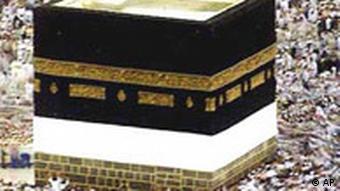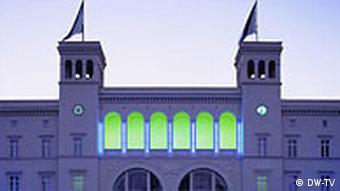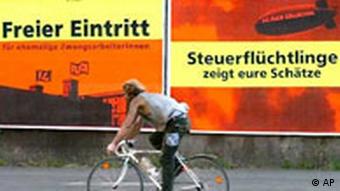Gregor Schneider has had the installation of his work "Cube" turned down for a second time.

The Kaaba in Mecca, surrounded by pilgrims
The first rejection came last summer, from the city of Venice. The artist, who had secured the Venice Biennial art fair's Golden Lion prize for Germany in 2001, developed "Cube" for this year's show. He had planned to install the work -- a six-by-six-by-six meter black stone cube -- in Venice's landmark piazza, St. Mark's Square.
Fear of terrorism
But city officials wouldn't permit the installation, saying it violated historic preservation rules. A reasonable enough argument, but many observers felt another reason for the decision was more likely: "Cube" unmistakeably evokes the Kaaba, the black square building at the heart of Mecca that is the holiest site in Islam.
St. Mark's Square is already high on some lists of possible terror targets; the city feared such a provocative artwork, prominently displayed, could anger Muslim groups.
Schneider proposed setting the work in the plaza in front of Berlin's contemporary art museum Hamburger Bahnhof, but that plan, too, appears to have been given the ax. This week, the museum's General Director, Peter Klaus Schuster, turned down "Cube Berlin 2006" saying the work is only suited for its original destination: St. Mark's Square.

The Hamburger Bahnhof museum in Berlin hasn't made a final decision
The artist contested Hamburger Bahnhof's rejection. According to reports in the German press, he said the work was not developed for any one site in particular, and claimed it evokes the "black square" paintings of 20th century artist Kasimir Malevich as much as it does the Kaaba.
Museum's role questioned
When Venice rejected "Cube" last summer, the German art world reacted strongly, calling the move political censure and warning that artistic expression is being compromised. Even the Central Council of Muslims in Germany also spoke out against the decision, saying such moves serve to squelch discussion about Islam.
But while the Venice call was understandable, the decision by the Hamburger Bahnhof appears to be less so, observers say. Contemporary art museums are not usually in the business of avoiding controversy, they note. The Hamburger Bahnhof exhibited the controversial Flick collection despite heavy criticism about the Nazi roots of its funding, they argued. Would the cube be any more controversial? Or is it, as the sculptor Schneider suggests, a fact that fear of terror is working to suppress artistic freedom from within?

The Flick exhibit brought protest --the owner's Nazi past was at issue
"How should an abstract cube look, in material, proportion, and size? … When does its association with the Kaaba begin, at what point can you talk about the origin of the term and the origin of the form?", Schneider wrote to the Hamburger Bahnhof administration.
But while some cultural critics are attacking art administrators for their weakness, others are attacking the art itself. The German newspaper tageszeitung implied that the reference to Islam was a publicity stunt, and that by offering to move it to Berlin, the artist lost his credibility.
"The cube is nothing special. Only its association with the Kaaba in Mecca and the original installation site lent it an explosive air, and brought the artist -- who, it must be said, has had little publicity of late -- back into the public eye," the paper wrote Wednesday.
It went on to say that the sculpture stood for the "Disneyfication of the world, the global Las Vegas syndrome."
While Hamburger Bahnhof's Schuster turned the sculpture down, the museum's response isn't final. Museum curator Eugen Blume wrote on Thursday that the discussion hasn't been finalized; the Kaaba-like "Cube" may yet come to Berlin. And either way, Sculptor Schneider has found his way back into the public eye.

